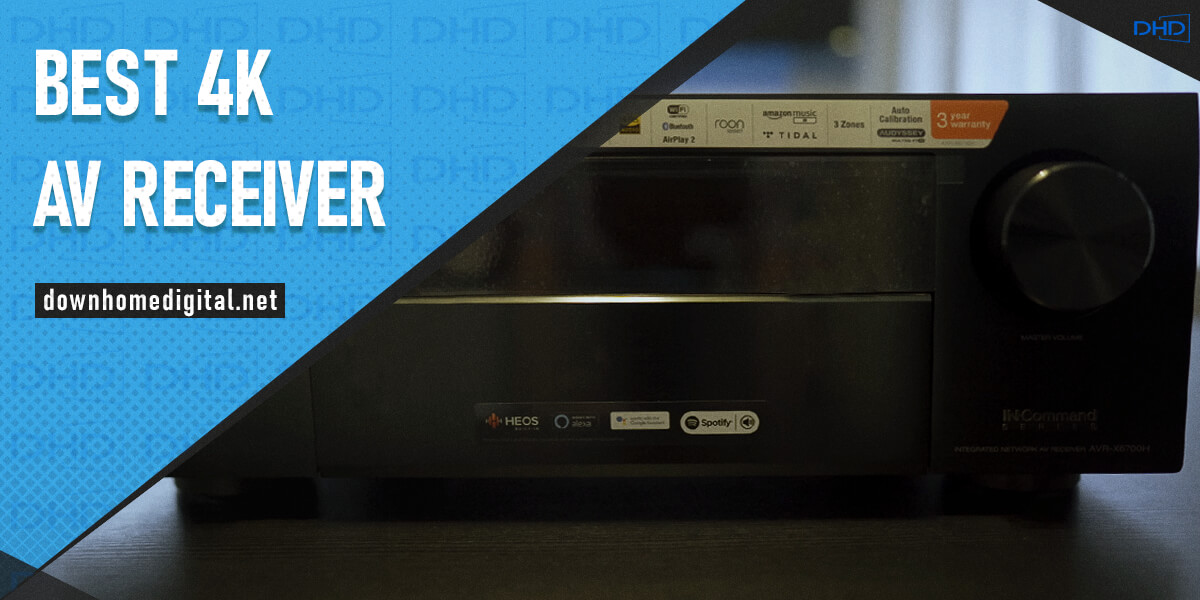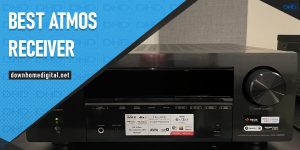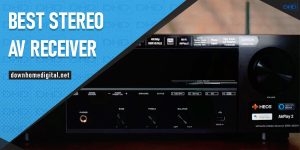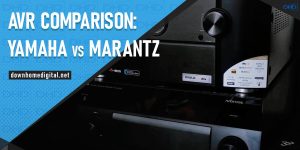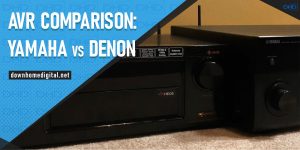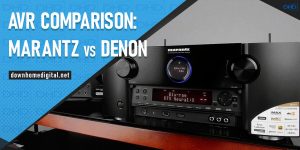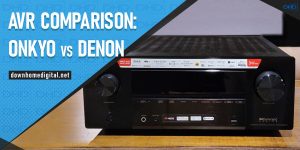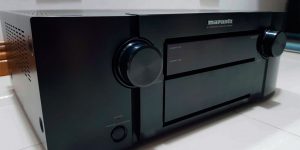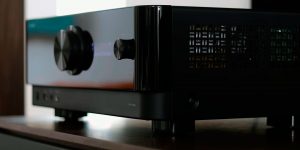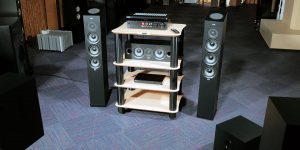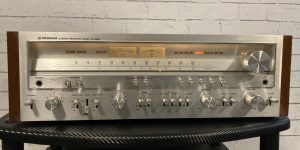Looking for the best 4K receiver? Or maybe you’re new to the topic and want to know why you need a receiver. If you are interested in these questions, you have come to the right place. First, let’s talk about the functionality of such a device. The AV receiver is designed to control your home theater system. Its main function is to receive audio and video signals from different sources and route them to their respective outputs. Nevertheless, modern AV receivers handle much more than audio signals. Nowadays, the AV device is the brain or the central processing unit of a home theater system. It brings movies to life and gives users many possibilities to get top-quality sound and image.
Have you heard about HDCP 2.2? It is a new generation of copy protection for the 4K era, and it probably will not work with any of your current gear. I want to say that maybe the TV or 4K AVR you bought last year might not be able to receive/pass all future 4K content. To successfully stream 4K or 4K HDR content, all devices connected via HDMI to your compatible streaming player must support HDCP 2.2.
The next thing that has to be considered is that to enjoy the 4K pass-through and 4K upscaling features, a High Speed HDMI cable is needed for the connection. I have tested many different ones. As for me, AudioQuest Pearl 48 HDMI cable is the greatest option since it has a perfect length (5 ft) and uses solid conductors to defeat strand-to-strand interaction, the major source of distortion in cables.
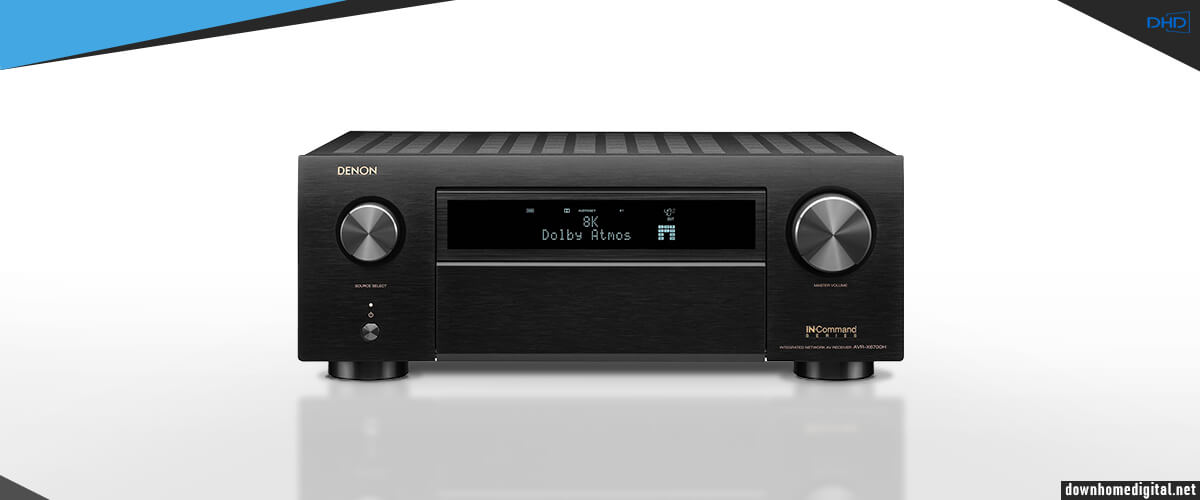
4K AV receivers comparison table
| Name | Channels | Power output | HDMI in/out | Bluetooth/Wi-Fi | Review |
|---|---|---|---|---|---|
| Denon AVR-X6700H best overall | 11.2 | 140W/8 Ohm, 175W/6 Ohm | 8/3 | yes/yes | Review |
| Denon AVR-S570BT budget | 5.2 | 70W/8 Ohm, 90W/6 Ohm | 4/1 | yes/no | Review |
| Marantz SR8015 premium | 11.2 | 140W/8 Ohm, 175W/6 Ohm | 8/3 | yes/yes | Review |
What does a 4K AV receiver do?
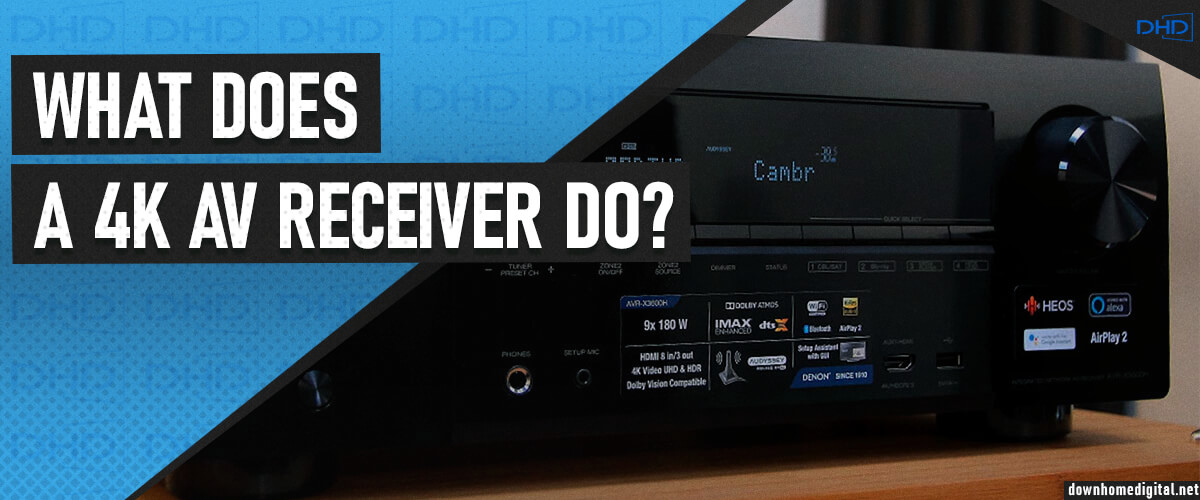
The 4K pass-through function allows data to be passed through the system without degrading image quality, provided it is HDCP 2.2 compliant. The AV receiver with 4K pass-through function reproduces 4K signals from video playback equipment on 4K-compatible TVs and projectors, while maintaining 4K quality (called 4K pass-through).
4K upscaling allows you to upscale low-resolution source video (such as Full HD (2K)) to 4K high-definition signals. Thus, AV receivers with 4K upscaling allow you to view Full HD video signals via HDMI in higher quality. In my 4K receiver reviews I will tell you about devices with 4K pass-through.
How I picked and tested 4K receivers
The configuration for the test of each best receiver for 4K TV was chosen with the video capabilities of the models in mind. To test and evaluate the image quality, video processing capabilities (upscaling, pass-through) and surround sound effects in the video, I chose the movie “Deadpool 2”. It has dialogs and a lot of action scenes with special effects. A perfect candidate for the test. The music, on the other hand, I decided to play on stereo speakers.
Used such equipment for the test:
- CD player SACD 30n
- Blu-ray player Sony UBP-X700
- Speaker wire – AudioQuest Type-9
- Speakers for movie – Klipsch RP-8060 FA
- Stereo speakers:
- Klipsch RP-8060FA
- KEF Q350
- DALI OBERON 5
Best 4K receiver reviews
Denon AVR-X6700H – best overall

This 4K surround sound receiver has a whole arsenal of innovations. In my rating, it takes the honorable first place because of the optimal price/quality ratio. Yes, it is not cheap and belongs to premium products. Still, it is cheaper than the Marantz SR8015 by a thousand dollars while retaining all the functionality of its main competitor, repeating the data almost one-to-one. The differences mainly concern internal components and construction quality.
Even externally, the AVR-X6700H looks like a premium Marantz, but it has a viewable LCD, which is important to me. Sure, you can use the on-screen menus or an app, but I’m a stickler for whatever is there to work well. The main group of button controls are hidden under the cover, so you won’t periodically pry the buttons loose from accumulated dirt. The weight of the receiver is 32 pounds, and that means using quality components. There’s no doubt about it when you hear the AVR-X6700H, though.
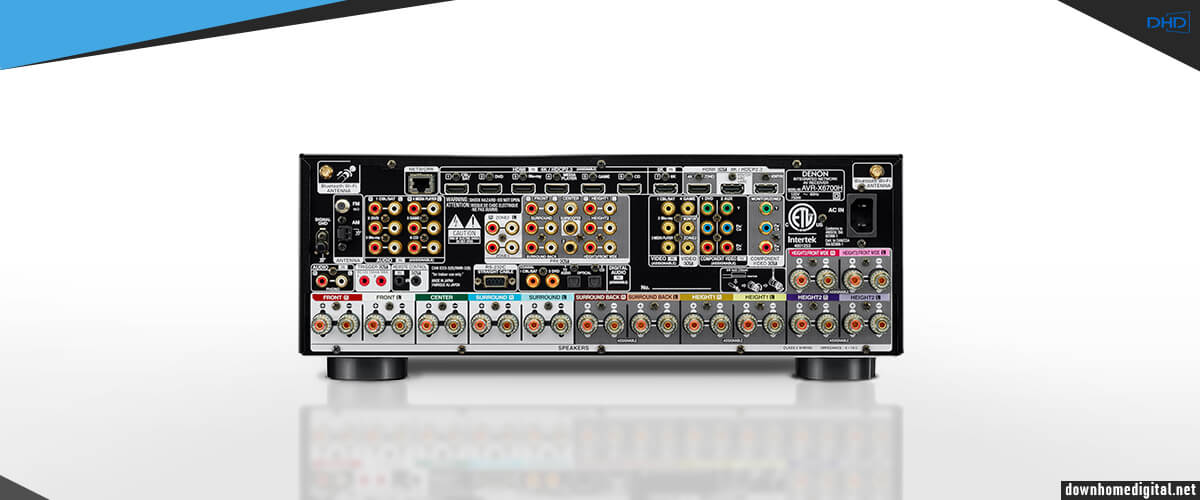
The number of HDMI ports is 8/3, and in my experience, this is enough even if you are a fan of large systems with huge equipment. Most likely, a couple of them will remain in reserve, and that’s good. But only 1 input supports 8K video resolution. I also say that I was pleased with the up-scaling from HD to 8K. The quality of the scaled image is great. I saw the colorful and bright image which does not look stretched, but it has good detail. However, I pay your attention to the configuration. If upscaling up to 4K works on all ports, then upscaling up to 8K – only on one.
Moreover, I discovered here 13 channel processing but only 11 power amplifiers (140 W at 8 Ohm or 175 W at 6 Ohm) here. Two extra channels need the installation of an external stereo amplifier to enlarge the speaker set. The AVR-X6700H also offers complete processing of 3D sound decoders such as DTS and Dolby. Besides, I think that the Auro-3D and cinematic IMAX Enhanced video technologies will satisfy even the most avid movie buffs. By the way, the correction of the interior features of the room is provided by Audyssey MultEQ XT32, and there is also an application called MultEQ Editor for more advanced settings.
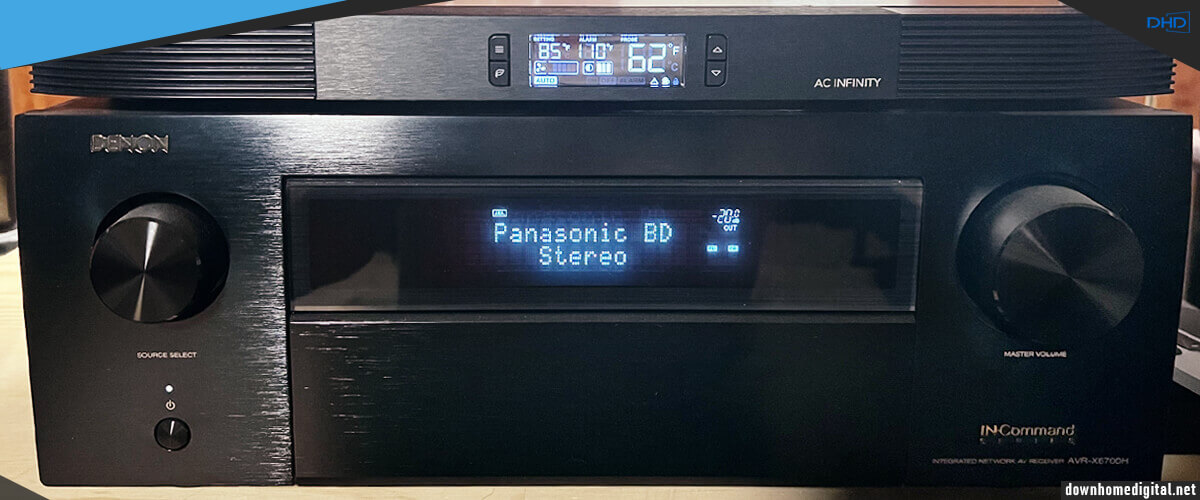
When I tested the sound, the first thing I noted was power! Each frequency register is fully audible. However, the balance is skewed more toward the bass than in the sound of the direct competitor – the Marantz SR8015. Besides, I should say that the sound is perceived as more controlled and mature, and the extra bass volume provides complete and realistic voices and, if necessary, is quite capable of shaking a room with its sound pressure. Combined with excellent up-scaling of HD images to the 8K resolution gives the right user experience.
I am always interested in details and expressive dynamics when listening to sound. And the Denon AVR-X6700H did not disappoint me in this aspect. For example, dialogs are rich and expressive when necessary, and when the action demands, they change into a more quiet tone. With this receiver, I watched Marvel (all parts of Guardians of the Galaxy). This series, for me, combines humor, action, and a wonderful soundtrack, which allowed me to study in detail the balance and dispersion of the model in question.
In terms of music, the AVR-X6700H is also very good. I especially liked the combination with the KEF Q750 front speakers. The improved Unit-Q driver array did an excellent job of handling mid and high tones, and smoothed out a bit too fat bass, which was extremely useful for Denon. I squeezed out the maximum 140W and heard no distortion whatsoever. It’s amazing!
Denon AVR-X6700H has all the specs of a unit which is the best 4K AV receiver in existence. It’s well-designed and sounds equally good for Hi-Fi as well for surround. With an extensive suite of 3D sound technology, this model is great for watching movies in big spaces. The receiver’s video and wireless functionality, power figures, build quality, and sound are as good as the premium Marantz SR8015, with the AVR-X6700H costing less.
The only drawback to the Denon AVR-X6700H that can be voiced is the overly saturated bass frequencies, which may put some of you off. But with the right acoustics, this issue can be solved. If you’re not chasing branded stuff and have sufficient finances – this is the perfect balanced, sensible choice of equipment for many years to come.
| Power |
|
| HDMI features |
|
| Video features |
|
| Network |
|
| Surround sound processing |
|
Pros
- Optimal price/quality ratio.
- Heavyweight indicates the use of quality components.
- Highest number of HDMI ports on the list, like the premium Marantz SR8015 with 8K support (1 input and 2 outputs).
- Scaling from HD to 8K showed great results.
- The system can be ramped up to 13 channels.
- No distortion at maximum power if you choose the right speakers.
- Multiple sound calibration options and support for almost all of the most popular surround sound formats.
Cons
- Some will want to turn down the bass.
Denon AVR-S570BT – budget
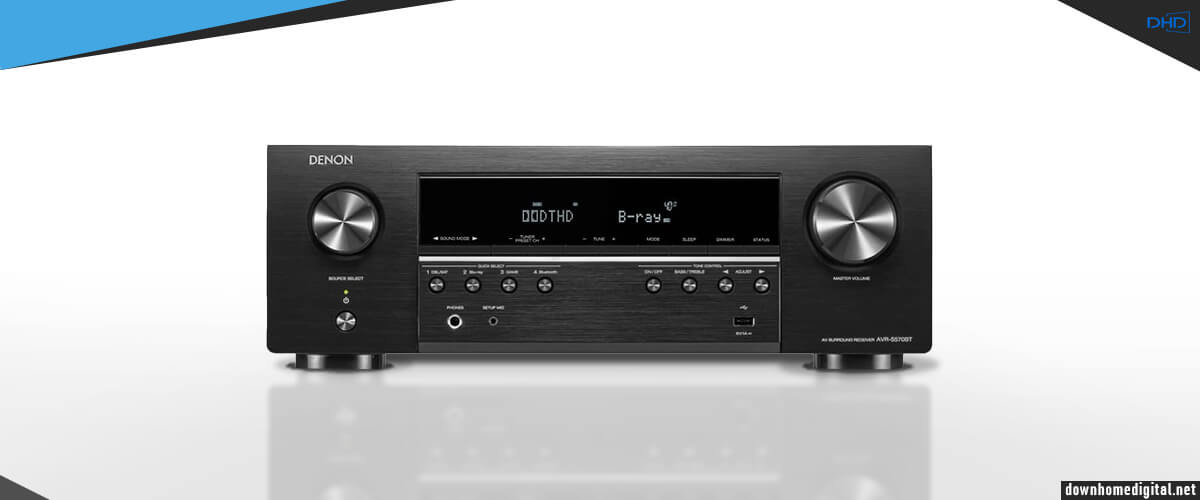
This review will primarily be of interest to newcomers to the world of home cinema systems or people who don’t want to spend a lot of money on a receiver at the moment. Meet Denon again, but this time the budget model – S570BT. This is the best budget 4K receiver of my ranking, as it’s released in 2022 and is the most modern device possible, costing you only a couple hundred dollars.
This basic model does not stand out in terms of design and functionality but has everything you need on board. The 5.2 channel receiver delivers 70W (8 ohms, 20 Hz – 20 kHz, 0.08% 2ch Drive). In my experience, that’s more than enough for small rooms. But you should realize that the construction of such a receiver is not notable for its durability and directly sags under your fingers. So, don’t remember it when installing it. However, the volume control is still on par with more expensive models, and it doesn’t scroll too fast and is tight enough. But the S570BT weighs 16.8 pounds, so it’s immediately clear how much simpler its internals are relative to the Denon AVR-X6700H.
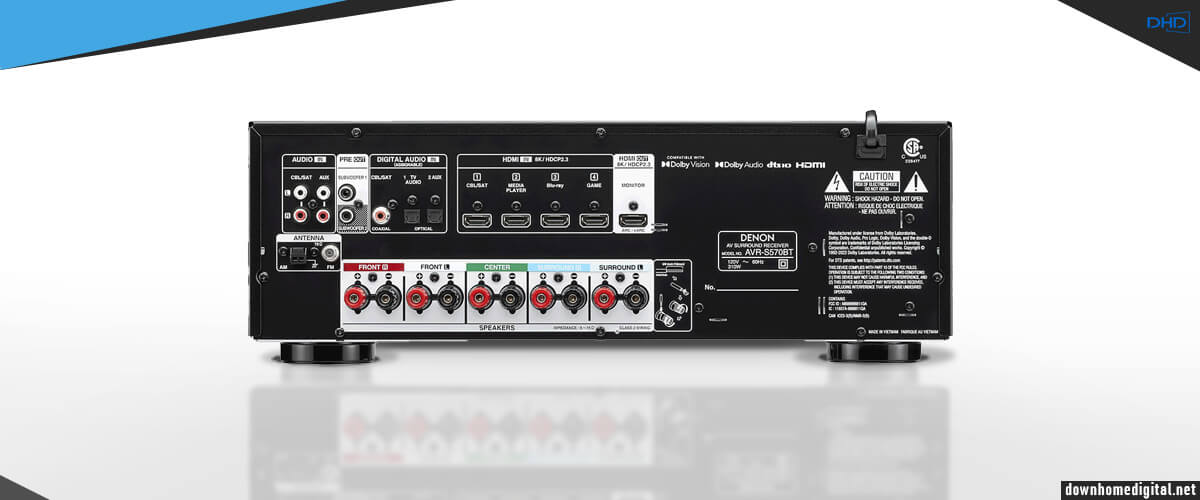
The Denon AVR-S570BT has 4 HDMI inputs and 1 output. There is ARC/eARC support as well as HDCP2.3. As for video capabilities, it can handle 8K/60Hz and 4K/120Hz and supports HLG, Dolby Vision, and HDR10+, as well as VRR and QFT. For a budget level, this is pretty good. The receiver can even scale video to 8K, but I wouldn’t trust this feature too much as the video freezes and generally doesn’t match the original 8K. But it is there if you need it too much; I only use it during testing but not daily. A resolution of 4K is quite enough for me.
As for sound, this 5.2 4K receiver supports older surround sound formats such as DTS HD Master and Dolby TrueHD. Not the most impressive set, but you will definitely experience new emotions from watching movies with the new sound.
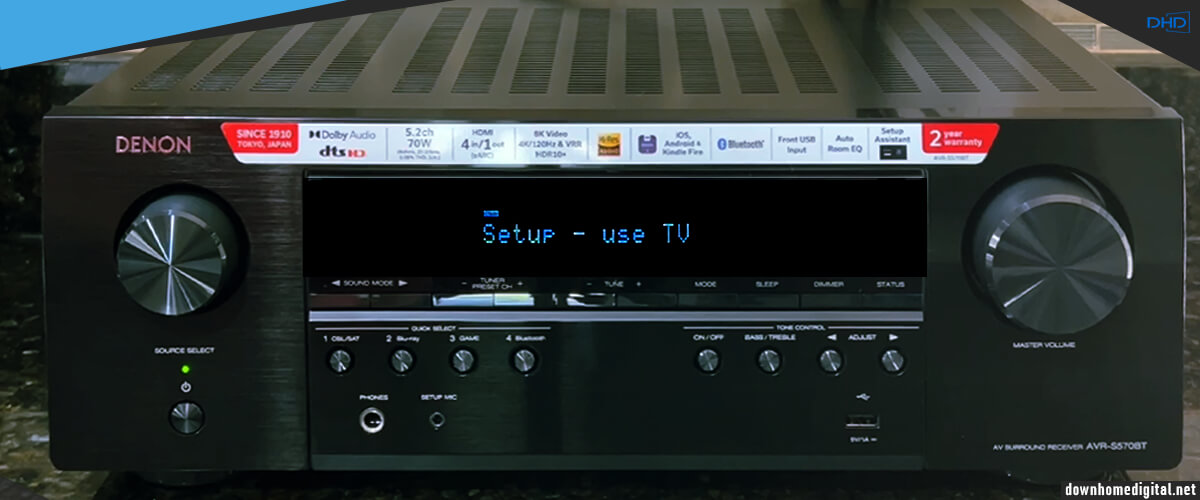
After setup, I did some testing and found the sound to be pretty good but certainly not great. The overall sound seemed to me a bit bright for audio-video and music. It’s definitely not the finest music solution, but knowing its class and price, I can’t demand more.
Denon AVR-S570BT retains the warmth and dynamics of the brand’s sound, and if you don’t crank the system to the max, you won’t be disappointed with a certain purity of sound. The only issue is that you won’t find wireless technology here besides Bluetooth. Nevertheless, I tried it out, and it works very well. There was no slack, so I listened to music from streaming services, and my phone’s audio library and I was quite satisfied with its quality.
At a very low price, the Denon AVR-X580BT is one of the most affordable yet advanced receivers on the market, as it was released in 2022 and is up to modern standards. However, this did not touch wireless technology, as the receiver has only standard Bluetooth, although its construction can be considered quality compared to other models with the same price. With support for 4/8K video, VRR, and QFT, as well as HLG and Dolby Vision, HDR10+s, good soundstage performance, and despite its simplicity and pretty good build quality, it gets its place in my rating.
I would recommend it to those who are more into movies and don’t want to splurge on buying premium equipment. It’s a great gift for a budding movie buff or teenager and can be used as an additional receiver in a garage, workshop, or nursery, as it’s weak and can only provide decent sound in a room up to 300 square feet (smaller is better).
| Power |
|
| HDMI features |
|
| Video features |
|
| Network |
|
| Surround sound processing |
|
Pros
- Extensive video features for viewers and gamers.
- All HDMI ports (4/1) support 8K and other benefits of version 2.1.
- It makes a good sound for its price.
Cons
- Flimsy case and low-quality components.
- The simplest 5.2 list system.
- The smallest power of 70W in my selection.
- 8K scaling doesn’t live up to expectations.
- No Wi-Fi.
Marantz SR8015 – premium
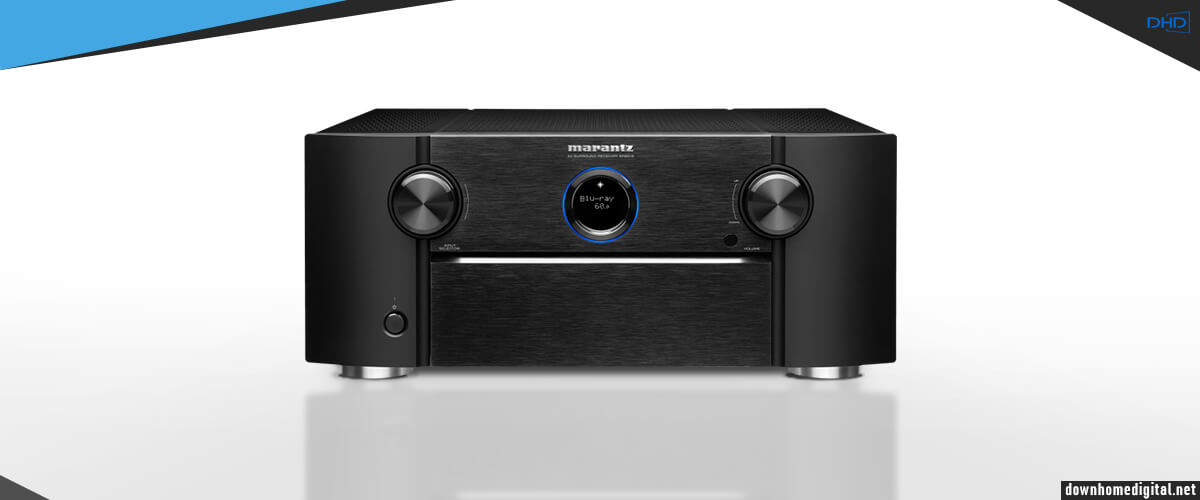
Marantz SR8015 is an 11.2-channel model expandable up to 13 channels capable of delivering 140 W/8 Ohm or 175 W/6 Ohm. The flagship of the SR series by Marantz. It is intended to conduct a large number of speakers perfectly and accurately and, by its parameters, is like a twin similar to the leader of my selection, Denon AVR-X6700H. But the cost of SR8015 is a thousand dollars higher. And that’s because the receiver is made with premium materials and the highest quality components. It is truly the king among all brands, but you pay for what you don’t see.
The Marantz SR-8015 uses the high-performance components of the brand to deliver high performance in both a home cinema mode and a Hi-Fi mode. Like many high-quality receivers of Japanese brands that I have already tested, SR8015 is equipped with power modules with HDAM technology. These components allow higher electrical voltages. They contribute to the musicality of this amplifier through better sound stage coherence.
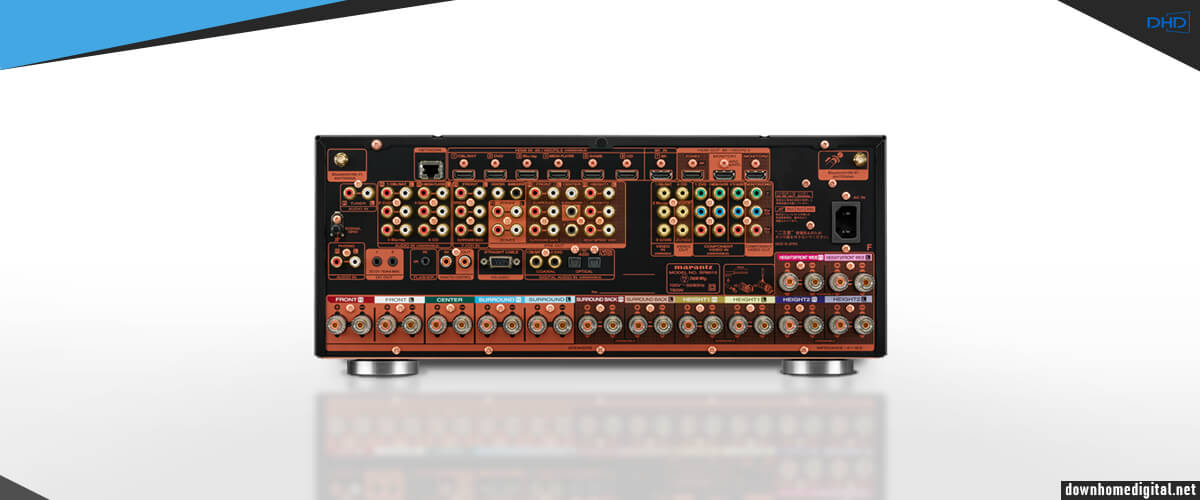
And even in look and feel, this model evokes a feeling of luxury, expensive equipment. All the controls, buttons, and connectors are of such high quality that it is worth paying more for them alone if you like truly quality things. The only thing I don’t like is the small round LCD, on which you can’t see anything even from a close distance. It’s there more for the beauty of design than for informativeness. But another rectangular and well-lit LCD is hidden under the cover on the front panel, so you can say that the manufacturer has solved both the issue of beauty and convenience.
AKM AK4458 DAC, operating at 32-bit levels on each channel, is entrusted with the digital-to-analog conversion in the Marantz SR8015. In addition, with a high signal-to-noise ratio and very low distortion, this high-end chip adds to clean and understandable sound reproduction. It’s also worth noting that this amplifier employs hybrid FAD technology to eliminate jitter.
The SR8015 has excellent sound effects. This receiver has superb attention to sound details. I also appreciate the frequency balance. When viewing a movie with multichannel sound, you can sense the natural depth of the sound scene and the accurate location of the items in it, which is not as obvious with the Denon AVR-X6700H’s sound. Needless to say, watching World War Z made me excited, I practically felt like I was in a movie theater. And despite Audyssey MultEQ XT32, LFC, and Compressed Audio Enhancer MDAX2’s advanced calibration and tuning systems, even an experienced user will need time to install and configure the system.
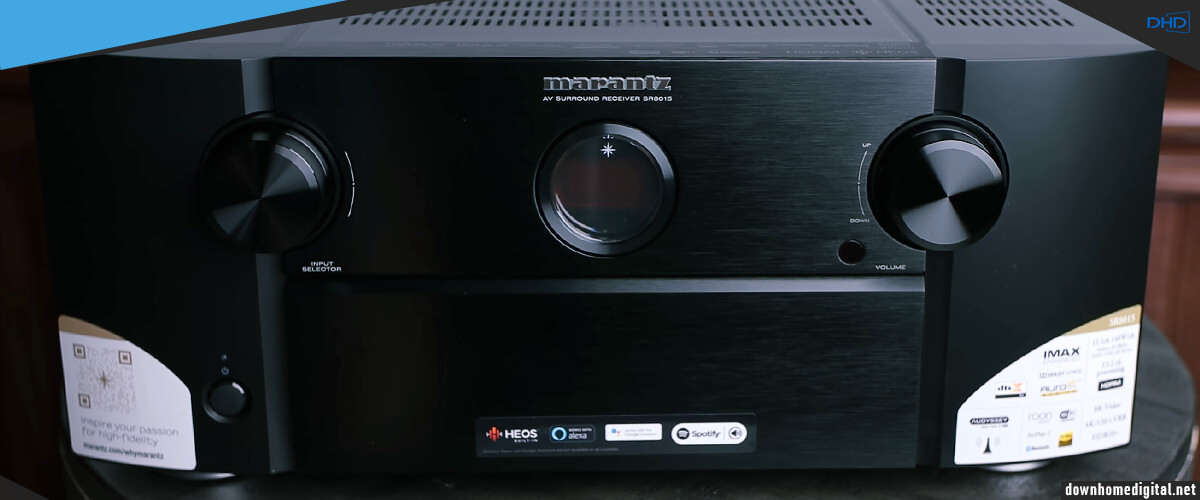
If you love music as much as I do and use vinyl and streaming services (plenty of which are built-in), the SR8015 will not disappoint. The HEOS works flawlessly, and the music flows so realistically that it sounds like it’s being recorded in my studio. But when it comes to vinyl, this receiver deserves the highest praise. I’ve tried many built-in phono stages, and the Marantz does the best job possible with analog sound. No, I’m not saying it’s as good as an external preamp, but it’s the phono stages in the receivers that I’m talking about.
I won’t describe the video capabilities of the SR8015, as they are one-to-one with the functionality of the Denon AVR-X6700H. However, I was still impressed with the upscaling feature from lower to higher resolution. The 8K image remains as detailed as possible even when upscaling from HD.
Powerful and functional, the Marantz SR-8015 is a great choice for home theater with a UHD 4K/8K TV or current generation gaming consoles for the ultimate premium gadget experience. It will provide you with everything you need today, but the Denon AVR-X6700H can do that, too. Do you have an extra thousand dollars?
Your choice may be driven by your love for expensive quality items, and by and large, that’s it. All the advantages that the Marantz offers relative to the Denon are hidden from your eye, and without perfect hearing or specialized equipment, you won’t even be able to recognize the difference in the overall sound picture. While I understand where the SR-8015 is superior, I’m all for balanced purchases. And with the extra thousand, you can upgrade your acoustics as well.
| Power |
|
| HDMI features |
|
| Video features |
|
| Network |
|
| Surround sound processing |
|
Pros
- The high cost is due to using high-end components in the design.
- HDAM technology contributes to the musicality of the amplifier.
- AKM AK4458 DAC operates at the 32-bit level on each channel.
- The 8K image remains as detailed as possible even when upscaling from HD.
- Advanced calibration system for more detailed customization.
Cons
- You’re overpaying for what you can’t see and can’t always hear.
- Customizing the unit is difficult.
Denon AVR-X3800H

Another representative of the Denon brand on my list is a 9.2-channel AVR-X3800H receiver, which has already managed to win the love of the many users since it meets modern standards. One of the main features of the receiver is the ability to expand up to 11 channels. Its power is 105W at an 8 Ohm load, and you can set this Denon receiver to 5.2.4 or 7.2.2 configurations or use a more powerful stereo amplifier to receive a 7.2.4 configuration signal. This model will appeal to those looking for a good system under $2,000.
The AVR-X3800H catches my attention with the video path: all 6 HDMI ports are version 2.1, allowing you to stream video in 8K at 60Hz or 4K at 120Hz (Dolby Vision, HLG, and HDR10+). You also have 8K upscaling and 3D pass-through here. It has fewer ports than the Marantz SR-8015 or Denon AVR-X6700H, but more of them with a modern interface.
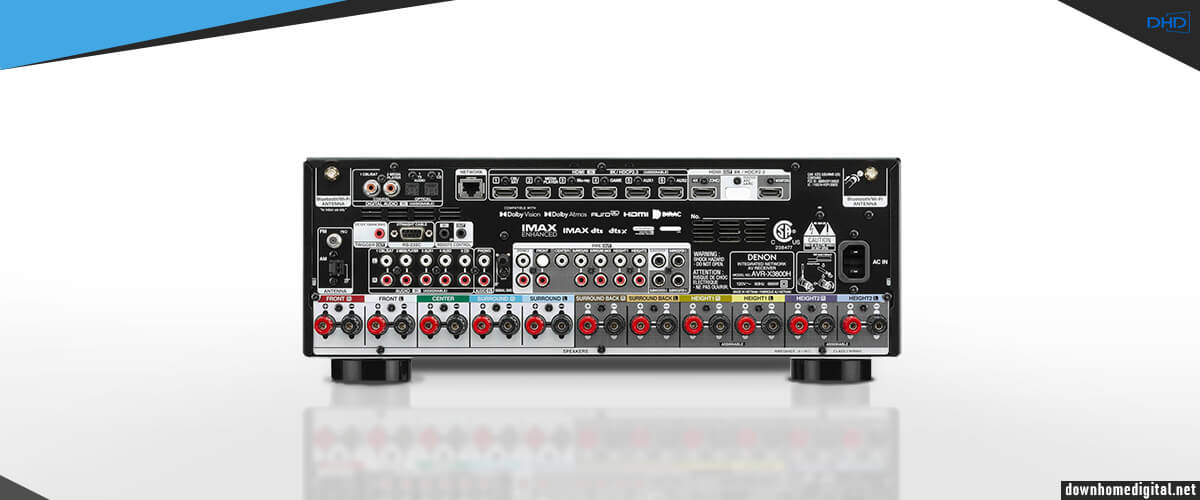
Surround sound formats are also state-of-the-art and include DTS:X (including Virtual:X, Neural:X) and Dolby Atmos, IMAX Enhanced, 360 Reality Audio, and Auro 3D with dual broadcast zones.
Connectivity options are varied and include Wi-Fi and Bluetooth (with voice assistants and streaming services including Roon Tested), phono input, built-in HEOS, and more. I really liked the level of wireless connectivity compared to other devices in the same price range.
As for a receiver of not the highest class, the sound is amazingly natural and effective. Denon doesn’t miss a single detail of the sound. It’s delightfully consistent from one speaker to the next and gives an authentic impression of the venue. And while I appreciate the warm sound of the AVR-X3800H, I can’t help but notice the difficult-to-use Dirac Live. You don’t have a detailed manual, so you’ll likely spend a long time perusing the manufacturer’s website and adjusting some settings manually, as I did.
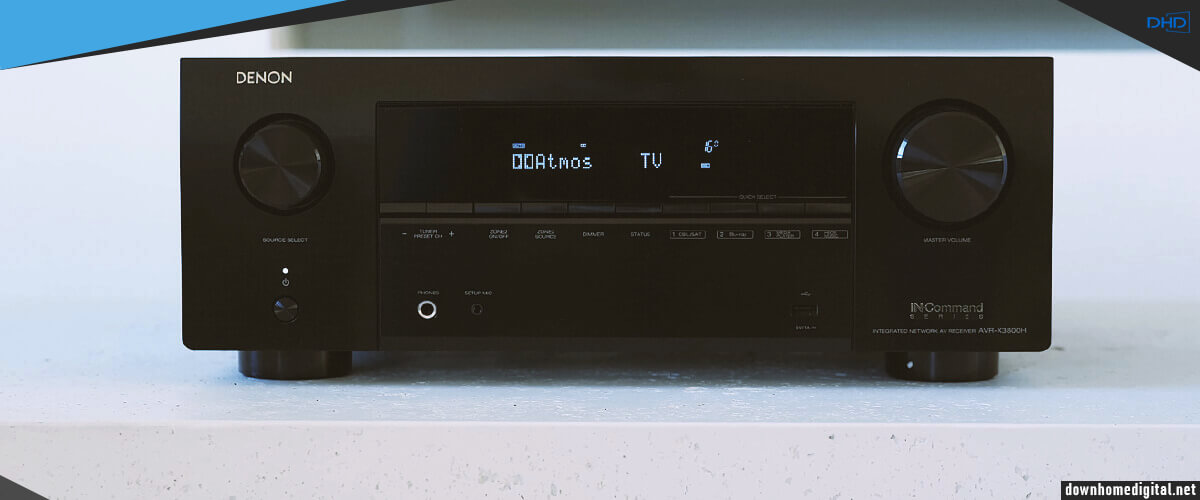
I’d also highlight the cool detail of tracks from my collection (supports high-resolution audio). The keyboard and acoustic instruments sound clean and finished, with excellent texture. Sounds do not merge into a single cacophony but sound exactly as they should.
Based on the test results, I can say that Denon AVR-X3800H is a very well-balanced device that combines excellent 8K ultra-high-resolution pictures with beautifully detailed and powerful sound. Once again, Denon engineers have worked wonders, and I consider this model one of the best 4K 120Hz receivers.
This model is suitable for those who want to save a little money compared to the premium Marantz SR-8015 and Denon AVR-X6700H but still own a high-quality modern device (model of 2022). Saving a few hundred dollars in your pocket, you will lose in the number of channels (there are 9 with the possibility of expanding up to 11), the number of HDMI ports (inputs here are 6, not 8), and in the quality of internal components, in which many of you do not understand. Only your ambitions are important in this matter.
| Power |
|
| HDMI features |
|
| Video features |
|
| Network |
|
| Surround sound processing |
|
Pros
- All HDMI ports (6/3) are version 2.1 and support 8K video.
- The receiver has advanced features and supports the latest audio and video formats at an affordable price.
- Supports most modern surround sound formats like more expensive receivers in the selection.
- A full suite of wireless multimedia technology is present.
Cons
- Less power than Marantz SR-8015 and Denon AVR-X6700H.
- Fewer HDMI ports than the premium rating leaders.
- The Dirac Live program is quite difficult to learn and set up for beginners.
Discontinued models
In this section, I want to introduce you to two models that have already been discontinued but fit the theme of the review and can become worthy centers of your home theater. They are currently underpriced, as they have been produced for quite a long time (2017 and 2018), but their functionality and performance are all relevant.
Sony STR-ZA3100ES
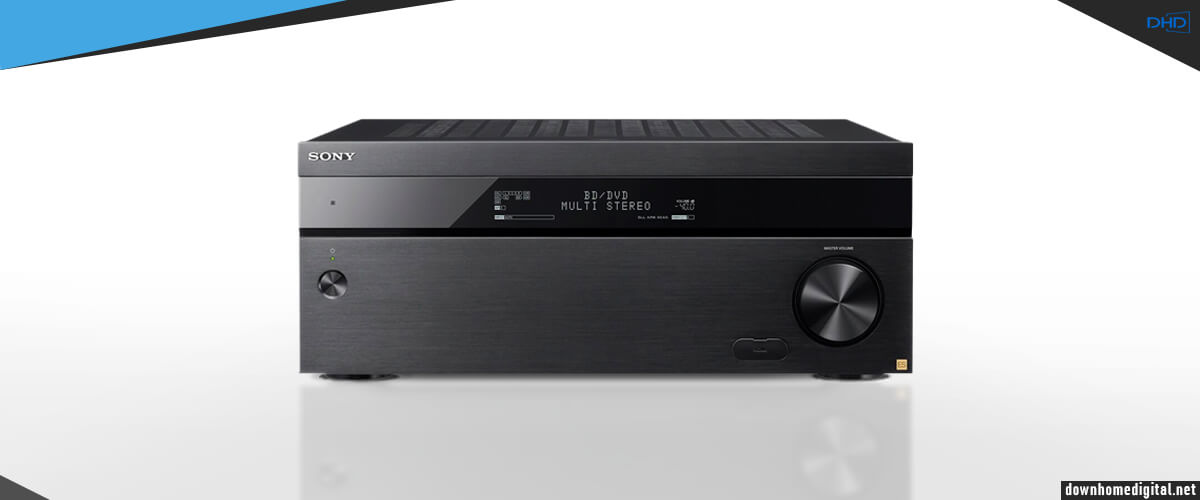
The iconic model of the Japanese company Sony STR-ZA3100ES once won the hearts of fans because it has not just important but also unique features. You can consider it an alternative to the AVR-X3800H, although it is inferior to the latter in many ways. Nevertheless, you may find users among you who will appreciate the cooler electronic sound of the receiver compared to the warm Denon sound.
The model in question has an interesting minimalist design, and the main control is under a fully removable cover (not hinged). I like that I can remove it completely during testing without the risk of ripping it off with an awkward movement. The LCD is bright and informative, but the buttons are rather small and recessed into the body. It all looks pretty nice, though. I wouldn’t be ashamed to have such a device in my rack.
The first thing that sets Sony ZA3100E apart from its competitors is that the manufacturer is positioning its device as an excellent choice for home movie viewing. And it’s not just because of its Dolby Atmos support and advanced video circuitry. It’s mainly because the receiver has a Phantom Surround Back feature which provides surround sound that simulates two additional channels. In a 5.1 configuration, for example, it simulates the effect of having a 7.1 system.
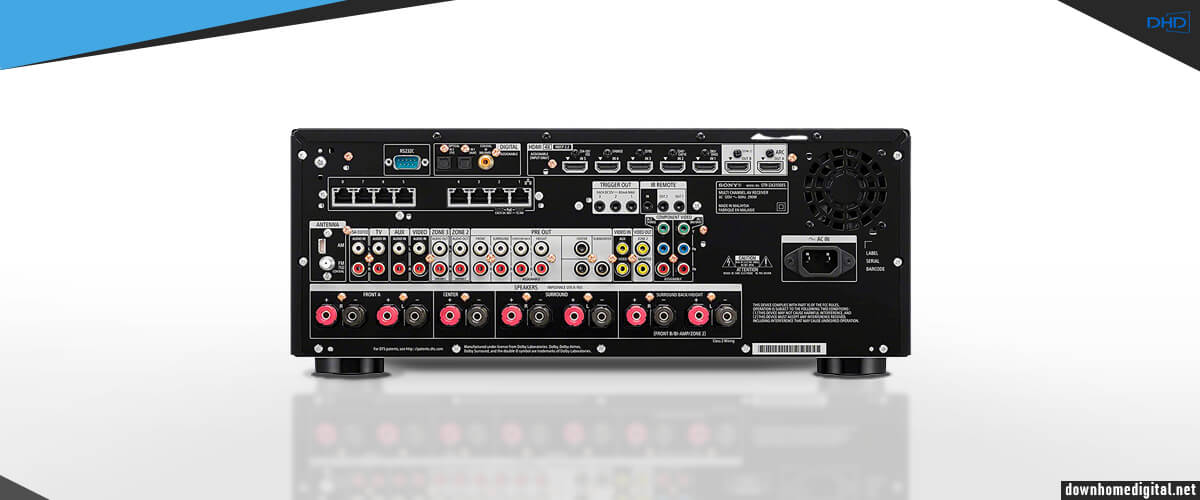
I should also mention that this 7.2 4K receiver outputs an actual 110 W/8 Ohm at seven channels of amplification but can boost up to 9 (using an external amplifier) +2 simulated media via the Phantom system. This means you can have more channels but fewer speakers. I think this is great, with the system sounding almost full when you use the simulation channels.
Since the model is older, its video features are inferior to those of the AVR-X3800H. It has fewer HDMI ports (6/2), all supporting only 4K video and providing HDCP 2.2 content protection. That’s good enough for me as I rarely use the features for 8K in my daily life; there’s still too little content to overpay for more resolution. The upscaling to 4K, on the other hand, impressed me. Not all, even the most advanced receivers, can produce such a high-quality virtual picture.
Also, STR-ZA3100ES does not have advantages in wireless technologies, as the receiver only has Bluetooth. With no Wi-Fi and no multi-room wireless audio, it feels like the obsolescence of a rather expensive model. You can only connect to a network via Ethernet.
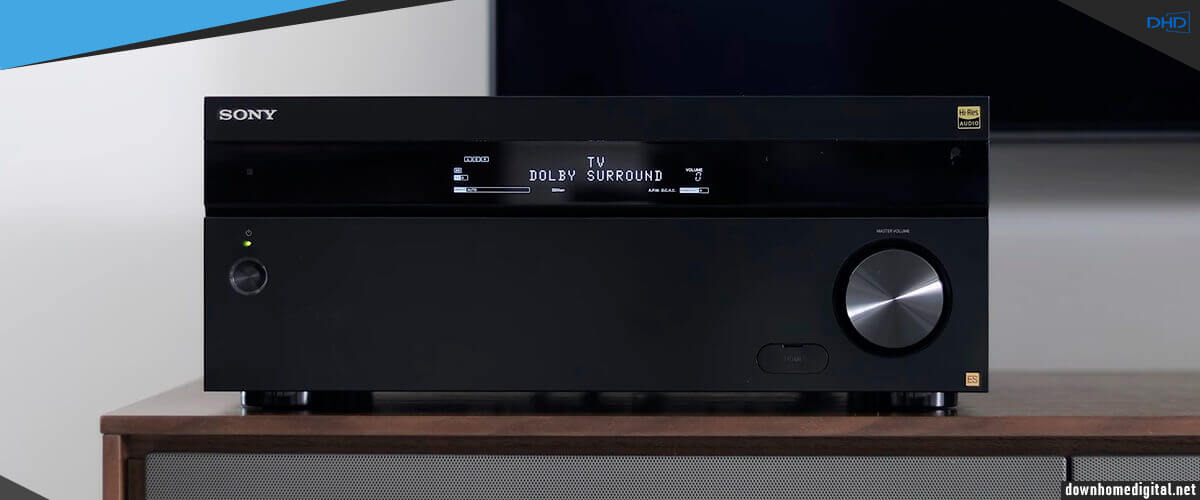
Using the test configuration, I was able to appreciate the musical capabilities of this receiver fully. In the stereo configuration, the STR-ZA3100ES gives an excellent detailed sound that brings out the instrumental parts of songs perfectly. When watching a movie, the surround sound perfectly captured explosions and object positioning. In fact, I have nothing to pick on in the area of sound. It is high-quality, as it should be for a mid-segment receiver. And the specifics of sound are a matter of taste, and here, my heart fully belongs to Denon.
Sony STR-ZA3100ES is a good 4K home theater receiver from a reputable Japanese brand with many features to create a true home theater experience. These include full 4K/60Hz support with upscaling capabilities that can put many modern models to shame and, in addition, high-quality surround sound with the ability to add virtual ceiling speakers.
You may prefer this receiver if you’re not into streaming music, as it has no wireless technology besides Bluetooth. It also doesn’t know what 8K video is, if that’s important to you, and it has fewer HDMI ports than the AVR-X3800H at the same price. I believe Sony could have discounted the price more since the STR-ZA3100ES is no longer up to today’s standards. But still, I can understand that you can pay more for the quality of internal components; Sony did their job here at a high level, and the receiver can serve for many years without fear of being broken.
| Power |
|
| HDMI features |
|
| Video features |
|
| Network |
|
| Surround sound processing |
|
Pros
- Fully removable cover on the front panel.
- You can use fewer speakers but get a system with more channels because the Sony STR-ZA3100ES has a Phantom Surround Back.
- The upscaling to 4K is excellent.
Cons
- Channel simulation doesn’t give a full-blown sense of the original configuration, but it’s not bad overall.
- Regarding video features, the receiver is inferior to the Denon AVR-X3800H.
- No Wi-Fi.
- No built-in wireless multi-room system.
Yamaha RX-V685
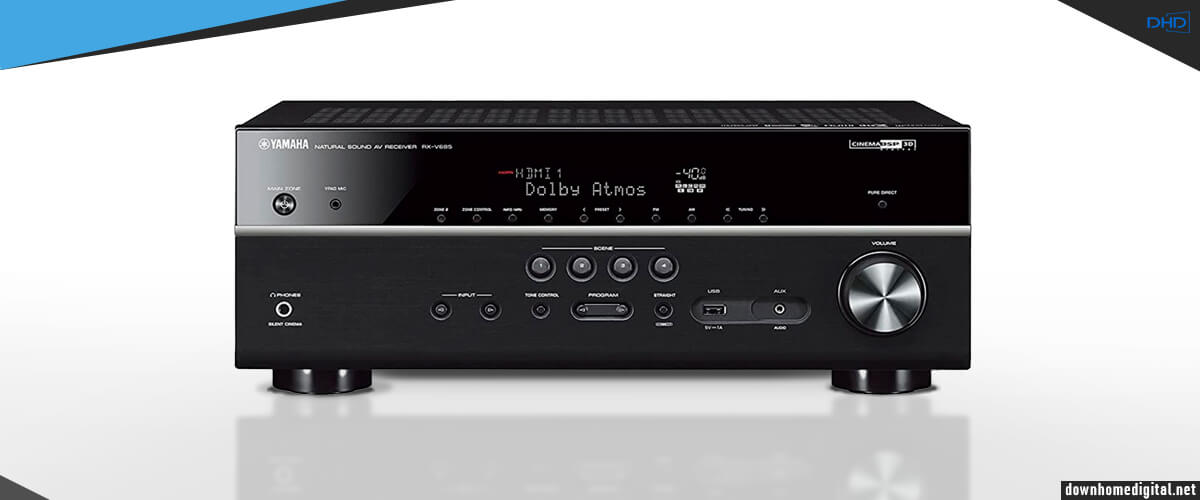
I’ll continue my review with another extraordinary model. The Yamaha RX-V685 combines basic functions, a number of additional features, and is equipped with fairly high-quality components, including the famous Burr-Brown 384 kHz/32-bit DAC, consisting of four Texas Instrument PCM5102A DACs.
Being a budget receiver, the device nevertheless inspires pleasant impressions with its appearance. You can feel the brand’s quality, even its weight is quite solid (23.1 pounds), which makes it a bit different from the Denon AVR-X580BT. I also liked the remote control, which is pretty self-explanatory, and the detailed instruction manual, something that is lacking in modern devices. Yamaha even made a stand for the calibration microphone.
This equipment operates with seven channels (90 W at 8 Ohm or 150 W at 4 Ohm) that offer 7.2 Flat or 5.1.2 surround configuration modes, with the opportunity to select a channel dedicated to 3D effects. In addition, the receiver has the option of allocating two extra channels to Zone 2 – either with basic amplification or with bi-amplification.
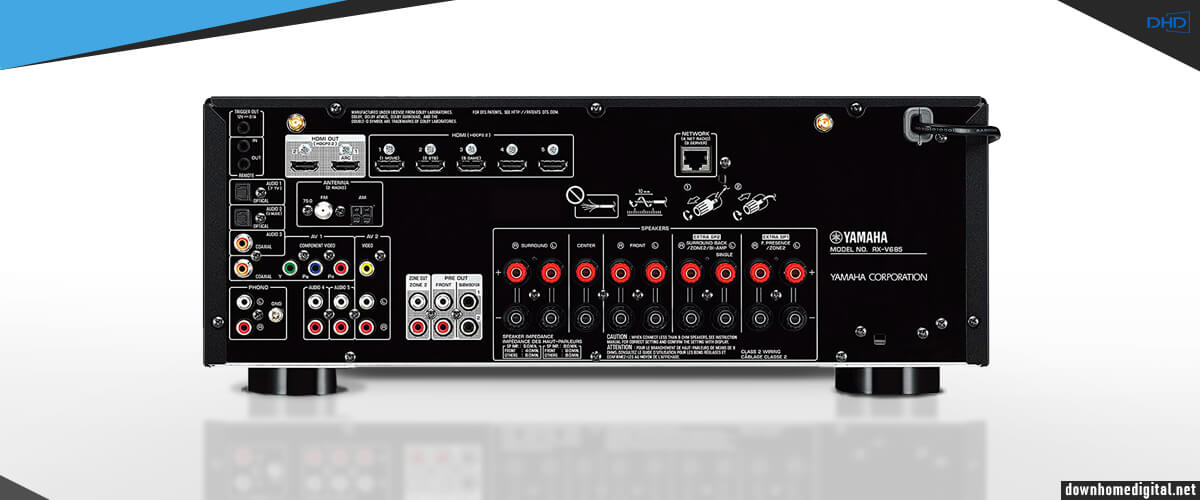
Besides, for me, the ability to add one or two wireless MusicCast speakers instead of the cabled or multi-room speakers is one of the coolest features of this model. It’s pleasant when you can safely walk around the room without the fear of getting your foot caught in the wire. And if you have small children, it is fundamentally important.
The video specs of this 7.2 4K receiver are quite extensive. There are 7 HDMI ports (5 inputs/2 outputs) supporting HDCP 2.3, HDR10 Dolby Vision/HLG, and BT.2020. With 4K video transmission at 60 frames per second, you can fully enjoy the 4K image quality without losing quality.
The RX-V685 supports a wide range of surround sound formats, including Dolby Atmos and DTS: X. There is also the proprietary CINEMA DSP 3D sound field shaping technology, as well as the brand’s standard YPAO (for correct acoustic tuning of a particular room).
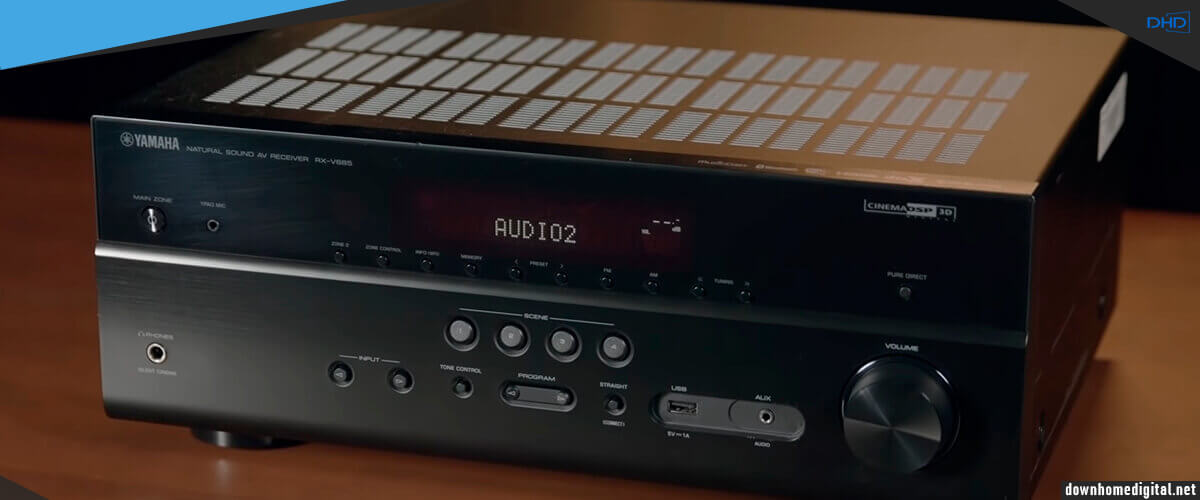
Yamaha never forgets its musical roots, and this 4K HDR receiver has all the analog inputs you need, including a phono input for a vinyl player. It has audio inputs on the front and rear. There are also four digital jacks, two optical, two coaxial, and a USB on the front panel. Given the advanced DAC, music playback, be it MP3, WAV, ALAC, or FLAC files, was a delight to my ears. So, if you prefer your system to be for movies and music, this receiver will suit you perfectly.
The more versatile a device is, the more complicated its setup and use can be, but not in this case. Yamaha has streamlined the setup process as much as possible, and you can control this receiver via transposition, remote control, or the web interface. As I’m sure you’ve already guessed, Wi-Fi and Bluetooth are present in this model as well. Although there are sometimes problems with Bluetooth connectivity.
The Yamaha RX-V 685 is sadly no longer in production, but you can still buy it (at least when I’m writing this review). The receiver is more expensive than the Denon AVR-X580BT by only a couple hundred dollars. Still, it is a good but simple 4K upscaling receiver that offers Dolby Atmos (7 channels instead of 5), which is suitable for listening to music, but all of its HDMI ports are for 4K video (Denon has 8K support). With the Cinema DSP 3D feature, you have peace of mind in how any movie you’re watching sounds, though the YPAO calibration system is far from Audyssey. You also get wireless technology that the Denon doesn’t have. But be prepared for the Yamaha’s sound to be more crystalline, too cold for many. It’s up to you to decide how much you need the features and if they are worth paying for.
| Power |
|
| HDMI features |
|
| Video features |
|
| Network |
|
| Surround sound processing |
|
Pros
- The built-in Burr-Brown 384kHz/32-bit DAC is excellent for music.
- More channels than the Denon AVR-X580BT (7 vs. 5) and support for Dolby Atmos.
- Cinema DSP 3D enhances the sound in movies.
Cons
- All HDMI ports only support 4K video.
- Sometimes, there are issues with Bluetooth connectivity.
- Yamaha sound may be too cold for some.
Buyer’s guide
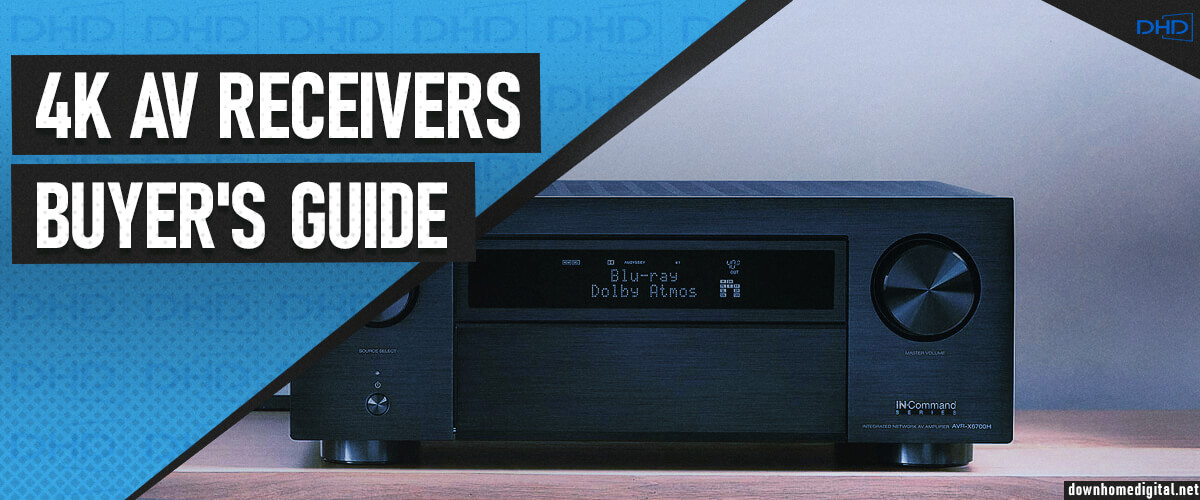
What is a 4K pass-through?
The 4K/8K pass-through function allows you to pass data through the receiver without any image quality processing, provided that all devices in the chain are HDCP 2.2 compatible. The AV receiver with the 4K/8K pass-through function plays back 4K/8K signals from video playback equipment on 4K/8K compatible TVs and projectors while maintaining the original quality.
Video upscaling in AV home theater receivers
Upscaling is scaling all incoming video signals to 8K or 4K resolution (depending on your TV). At low quality in their original form, they would look awful on your super-modern high definition TV. However, you can’t just stretch the picture – it would look even worse.
But different algorithms can be used for scaling. Some algorithms are fast but of lower quality. For more powerful devices, more complex algorithms are used. They provide a better quality of scaling.
Does the image become better when scaled?
It depends on what kind. If you scale, for example, SD to UHD, given the small number of pixels, the image will be of poor quality, just not enough pixels to improve the image. It is quite another thing to scale Full HD to UHD, in which case the pixels are pretty enough, and the image will be more detailed.
How does 4K scaling work?
Scaling an HD image to 4K requires several steps. The first is for the receiver to analyze the received signal to determine what type and resolution it is. Then noise reduction takes place, the receiver analyzes and “smooths out the edges” of the image, textures and works with detail, and then adds pixels to the original resolution to achieve 4K. It’s an incredibly complex process that requires powerful processors.
The receiver’s processor processes a vast amount of information, comparing how different elements of that image should look. Once this evaluation is complete, the image is projected to 4K quality.
The latest processors use AI, which scales the image at the pixel level. The work is not only done individually on each pixel but also on the pixels around it, on each diagonal, and on pixels across multiple frames to ensure consistent image quality.
In addition, the mashup process affects detail and image artifacts, and noise. This improves local contrast and color in the video.
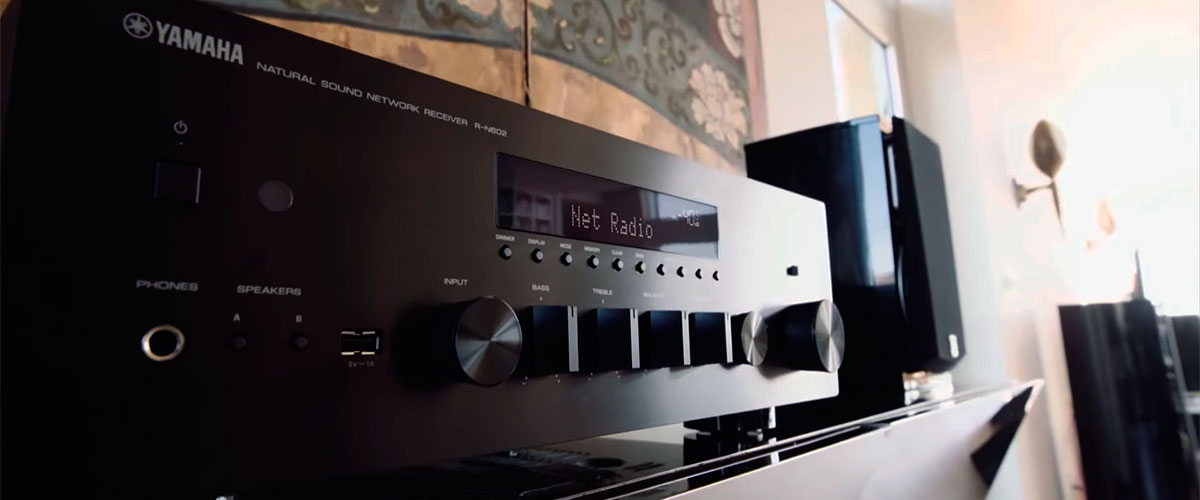
What’s the difference between 4K Ultra HD and 8K UHD
4K Ultra HD has a resolution of 3840×2160 pixels per frame. 8K has twice as many pixels on each side – 7680×4320 pixels. It turns out that one frame in 8K contains four times as many pixels as in 4K. Accordingly, devices require more memory for storage and higher processing and transfer speeds for an image with this resolution to run at all. To playback 8K video, you need a TV with the same resolution and a processor that can process the video or upscale the image at a lower quality.
Scaling 8K
8K resolution offers many more pixels than 4K resolution, for example, with the same screen diagonal. This means that 8K resolution has a higher number of pixels per inch (PPI), resulting in smaller pixels and much closer together, making it difficult to recognize individual pixels in the image.
Problems with the 8K?
On television with a low resolution, you are likely not to notice the difference between 4K and 8K content, simply because it is beyond the capabilities of human vision. You might see something if you sit 4-8 inches away from the screen or if your TV is more than 88 inches diagonal, but you will have to strain yourself and look for the differences on purpose. As for 8K content, for example, the YouTube app for Smart-TV generally streams video at its highest resolution of 4K, as do most online movie theaters.
While 8K video is hard to find, you can’t consider this resolution just a marketing ploy. For example, until recently, there were no YouTube clips in 4K, no movies, and no personal videos, even though UHD TVs were already being sold everywhere. Then came affordable technology that allowed you to shoot 4K video. Videos on various services followed it. They were followed by movies that were shot in 4K or just processed up to it. Now, this resolution is considered almost standard. The same path awaits 8K resolution.

